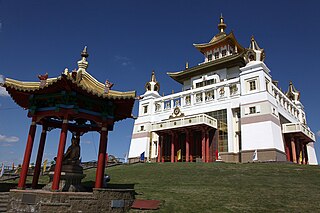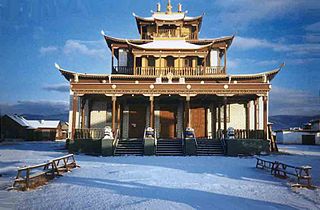Related Research Articles

The Mongols are an East Asian ethnic group native to Mongolia, Inner Mongolia in China, and the Republic of Buryatia of the Russian Federation. The Mongols are the principal member of the large family of Mongolic peoples. The Oirats in Western Mongolia as well as the Buryats and Kalmyks of Russia are classified either as distinct ethno-linguistic groups or subgroups of Mongols.

The United States does not have an official language at the federal level, but the most commonly used language is English, which is the de facto national language. In addition, 32 U.S. states out of 50 and all five U.S. territories have declared English as an official language. It is also the language spoken at home by the great majority of the U.S. population. Many other languages are also spoken at home, especially Spanish, according to the American Community Survey (ACS) of the U.S. Census Bureau; others include indigenous languages originally spoken by Native Americans, Alaska Natives, Native Hawaiians, and native populations in the U.S. unincorporated territories. Other languages were brought in by people from Europe, Africa, Asia, other parts of the Americas, and Oceania, including multiple dialects, creole languages, pidgin languages, and sign languages originating in what is now the United States. Interlingua, an international auxiliary language, was also created in the U.S.

The Kalmyks are a Mongolic ethnic group living mainly in Russia, whose ancestors migrated from the Dzungaria region of Mongolia. They created the Kalmyk Khanate from 1635 to 1779 in the south of the European part of Russia territory. Today they form a majority in Kalmykia, located in the Kalmyk Steppe, on the western shore of the Caspian Sea.

German Americans are Americans who have full or partial German ancestry. The 2020 census results showed over 44,978,546 Americans self-identifying as German alone or in combination with another ancestry. This includes 15,447,670 who chose German alone.

Oirats or Oirds, also formerly Eluts and Eleuths, are the westernmost group of the Mongols whose ancestral home is in the Altai region of Siberia, Xinjiang and western Mongolia.

The Kalmyk deportations of 1943, codename Operation Ulusy was the Soviet deportation of more than 93,000 people of Kalmyk nationality, and non-Kalmyk women with Kalmyk husbands, on 28–31 December 1943. Families and individuals were forcibly relocated in cattle wagons to special settlements for forced labor in Siberia. Kalmyk women married to non-Kalmyk men were exempted from the deportations. The government's official reason for the deportation was an accusation of Axis collaboration during World War II based on the approximately 5,000 Kalmyks who fought in the Nazi-affiliated Kalmykian Cavalry Corps. The government refused to acknowledge that more than 23,000 Kalmyks served in the Red Army and fought against Axis forces at the same time.

Kalmykia, officially the Republic of Kalmykia, is a republic of Russia, located in the North Caucasus region of Southern Russia. The republic is part of the Southern Federal District, and borders Dagestan to the south and Stavropol Krai to the southwest; Volgograd Oblast to the northwest and north and Astrakhan Oblast to the north and east; Rostov Oblast to the west and the Caspian Sea to the east. Through the Caspian Depression, the Kuma river forms Kalmykia'a natural border with Dagestan. Kalmykia is the only region in Europe where Buddhism is the predominant religion.
This article details the geographical distribution of speakers of the German language, regardless of the legislative status within the countries where it is spoken. In addition to the Germanosphere in Europe, German-speaking minorities are present in many other countries and on all six inhabited continents.

The term American Buddhism can be used to describe all Buddhist groups within the United States, including Asian-American Buddhists born into the faith, who comprise the largest percentage of Buddhists in the country.

The Kalmyks are the only Mongolic-speaking people of Europe whose national religion is Buddhism. In 2016, 53.4% of the population surveyed identified themselves as Buddhist. They live in Kalmykia, a federal subject of Russia in the southwest. Kalmykia borders Dagestan to the south, Stavropol Krai to the southwest, Rostov Oblast to the west, Volgograd Oblast to the northwest, and Astrakhan Oblast to the east. The Caspian Sea borders Kalmykia to the southeast.
Tibetan Americans are Americans of Tibetan ancestry. As of 2020, more than 26,700 Americans are estimated to have Tibetan ancestry. The majority of Tibetan Americans reside in Queens, New York.

Russian Americans are Americans of full or partial Russian ancestry. The term can apply to recent Russian immigrants to the United States, as well as to those who settled in the 19th century Russian possessions in northwestern America. Russian Americans comprise the largest Eastern European and East Slavic population in the U.S., the second-largest Slavic population generally, the nineteenth-largest ancestry group overall, and the eleventh-largest from Europe.

The peoples of the Caucasus, or Caucasians, are a diverse group comprising more than 50 ethnic groups throughout the Caucasus.
Ngawang Wangyal, aka Sogpo (Mongolian) Wangyal, popularly known as Geshe Wangyal and "America's first lama," was a Buddhist lama and scholar of Kalmyk origin. He was born in the Astrakhan province in southeast Russia sometime in 1901 and died in West Palm Beach, Florida in 1983. He came to the United States from Tibet in 1955 and was the spiritual leader of the Kalmuk Buddhist community in Freewood Acres, New Jersey at the Rashi Gempil-Ling Buddhist Temple. He is considered a "founding figure" of Buddhism in the West.

Although there was regular contact between practising Buddhists and Europeans in antiquity the former had little direct impact. In the latter half of the 19th century, Buddhism came to the attention of Western intellectuals and during the course of the following century the number of adherents has grown. There are now between 1 and 4 million Buddhists in Europe, the majority in Italy, Germany, Hungary, France and the United Kingdom.
Mongolian Americans are American citizens who are of full or partial Mongolian ancestry. The term Mongol American is also used to include ethnic Mongol immigrants from groups outside of Mongolia as well, such as Kalmyks, Buryats, and people from the Inner Mongolia autonomous region of China. Some immigrants came from Mongolia to the United States as early as 1949, spurred by religious persecution in their homeland. However, Mongolian American communities today are composed largely of migrants who arrived in the 1990s and 2000s, as the Socialist Mongolia gradually collapsed and restrictions on emigration were lifted.

Erdne-Basan Ombadykow, also known as Telo Tulku Rinpoche, is the Tibetan Buddhist spiritual leader of the Kalmyk people. He received his formal training as a bhikṣu in India and was recognized by the 14th Dalai Lama as the current reincarnation of mahasiddha Tilopa.

Historically, Buddhism was incorporated into Siberia in the early 17th century. Buddhism is considered to be one of Russia's traditional religions and is legally a part of Russian historical heritage. Besides the historical monastic traditions of Buryatia, Tuva and Kalmykia, the religion of Buddhism is now spreading all over Russia, with many ethnic Russian converts.

Freewood Acres is an unincorporated community located within Howell Township in Monmouth County, in the U.S. state of New Jersey. The area is made up of mostly single-story homes arranged along a street grid in the northern reaches of the Pine Barrens. U.S. Route 9 runs through the center of the community just north of its interchange with Interstate 195. The Land O'Pines Elementary School and Manasquan Reservoir County Park exist to the east of the community. It became the center of the Kalmyk American community in the latter part of the 20th century.
Kalmyk Buddhist Temple, also known as Kalmyk Home, was a Buddhist temple in Belgrade, capital of Serbia. It was built in 1929 as one of the first Buddhist temples in Europe, served for the religious purposes until 1944, and completely demolished in the mid-1960s.
References
- ↑ American Kalmyks, narrated documentary, archived from the original on 2021-12-19, retrieved 2020-01-20
- ↑ Encyclopedia of New Jersey. Rutgers University Press. 2004. p. 434. ISBN 9780813533254 . Retrieved 29 March 2021.